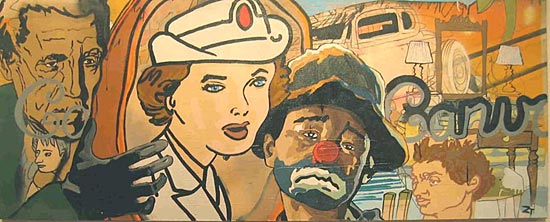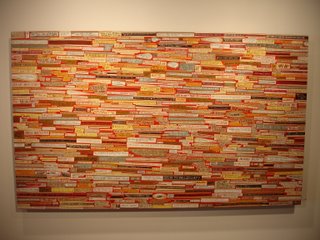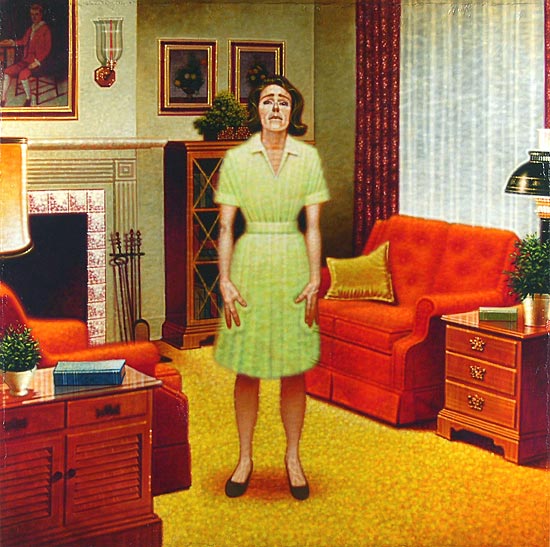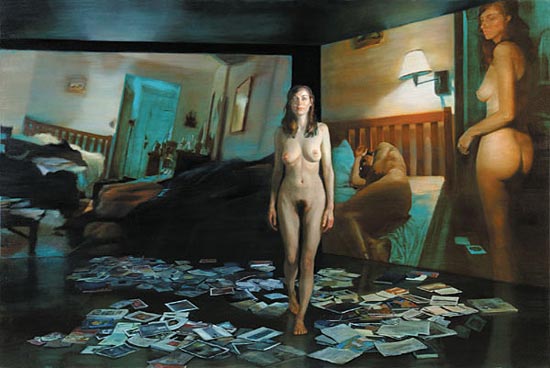New Work in the Collection from this Gallery includes pieces by:
ZACH TAYLOR
"MISS MEND"

LORA FOSBERG
"I Love Chocolate"


ARTIST STATEMENT
In an attempt to utilize metaphor, memory, iconography, and narrative, my work expresses conscious life in its most banal forms. My attempt is to transform objects and events of every day life into symbols of the universal, thus enabling me to participate within a large and complex audience.
My process is that of the historian: experiencing, assembling, and finally, recording into history, vague and seemingly impenetrable information. The intent is to utilize a vocabulary of routine images or vignettes that suggest the familiar while maintaining ambiguity.
The subjects of my work are the subtle intricacies and intimacies of life. The memories of a universal yet personal childhood, the interrelationships of emotions, and the perceptions of the mundane aspects of everyday life. The specific and the generalized, the personal and the universal, all hold equal importance in my work.
The work is attempting to bring the viewer into a place where I am able to disarm them with imagery allowing them to regress back to a particular memory; a specific moment forever embedded in the brain......whether it be truth or a complete fabrication of the subconscious, the memory has created it nonetheless.
The artwork is not to be a part nor copy of the real world, but a world in itself: independent, complete, autonomous; to understand it fully the viewer must enter that reality or world and conform to its laws.
Connection to the individual is what I seek, and what the individual viewer seeks from me. Connection to the past, to one another, to the physical world, to the spiritual. To remind the viewer of feelings, thoughts one didn't even know they had forgotten, thus enlarging emotional possibility.
Lora Fosberg 2005
New Piece from LORA FOSBERG:
“The Last True Story I’ll Ever Tell”

Yes to Everything! in which she continues her exploration of the contemporary human condition and further develops her language as a visual artist/social commentator/shrink. (Not literally… though Fosberg sometimes does draw on actual doctor’s prescription notepads to seemingly offer up remedies, though definitely no cure, to the sickness and dysfunction of our lives). Using the recognizable language of the comic world as the basis of her well-crafted work, Fosberg cleverly and unpretentiously matches form with content and gives a fresh look at familiar ground – the “stuff” of our every day lives; the trials and tribulations; the foibles and frailties of our being; the interrelationships of diverging and contradictory emotions; the universal. She reassembles her drawings and text into collages mounted on panels, or a series mounted together as an installation (that could be hung innumerable ways) that allows her work to be read like a visual journal, one in which all the pages become visible at once but are undetermined by the traditional narrarative set by the linear passage of time. Small vignettes are enough to elicit a stream of consciousness of unpredictable associations. And hence, the designation of shrink – she won’t give you the answers - she raises the issues and obliges us to figure it out for ourselves.
In the piece entitled “The Last True Story I’ll Ever Tell” (though hopefully there may still be a sequel in store) Fosberg takes off from where she left off after her recent exhibition at the Museum of Contemporary Art in Chicago’s 12 x 12 space in January 2006 where a large piece (4’ x 12”) entitled “The First True Story I’ve Ever Told” was on display. As before, the piece is comprised of phrases Fosberg has jotted down over the years in her journals, whether of simple (though profound and often very witty) observations she has made of life, conversations she has had or overheard, lyrics of songs that ring true to her, are all rewritten, collaged and rearranged randomly to create an extremely engaging composition (that nonetheless connects to the familiar and universal of the viewer).
The notion of exposure and exposing oneself runs rampart throughout Fosberg’s work. Beyond the occasional nudity, both spiritually and psychologically, layers of ideas and emotions are laid bare. To further this point, Fosberg continues to utilize a newer technique in which she pours paint over raw silk on stretchers. The silk’s translucence suggest skin to the visible skeleton of the stretcher bars and a peeling back of the onion making the “self” more revealed. The information in much of these works is pared down to a minimal, as in “The Silent Mushrooms Call Us Into the Forest” were the open space, removed from human drama, suggest the best cure of all – refuge from the deluge of all the “stuff” of our lives.
Lora Fosberg, who resides in Chicago, received her MFA from the School of the Art Institute in 1992. She has exhibited in galleries throughout the country and her work is in many private and corporate collections.
PETER DRAKE
http://www.peterdrakeartist.com
"Out of Place"

Artist's Statement:
"I believe that all pictures have various levels of meaning; there is the original intention and then everything beyond that intention. The most magical aspect of pictures is the degree to which they exceed their original intentions.
Lately I've been going through a large collection of images from the 50's, 60's, and 70's looking for pictures whose meanings have shifted with time. I am drawn to the ones where what might have been a "hidden subtext" has emerged over the years as the primary text. I find myself thinking, " this shouldn't be happening here." It's the sense that as time progressed, so did the image and that its' true meaning has only now become clear. To heighten their new meaning, I then take those images and combine them with others from the same era. As a procedure this has obvious surrealist precedents but unlike the surrealists who chose complimentary or oppositional motifs to make you aware of their disruptions, I choose from analogous or like-minded motifs so that the rents in the fabric are barely noticeable.
An image of a father and a daughter playing "horsey" can seem completely innocent to one generation and laced with malignant overtones to another. The giddy laughter of little girls from one era can seem maniacal to the next. What was a simple act of spraying pesticides on a front lawn can seem insanely threatening to a more organic world. My thinking is that if my interventions are too obvious it will be too easily categorized and the painting will loose its ability to disrupt. Ultimately I feel the strangest and strongest paintings are the ones where you know something is wrong but you just aren't sure what it is."
Artist's Website: http://peterdrakeartist.com
JENNIFER PRESANT
"Projection Memory Desire"

Artist's Statement:
Jennifer Presant draws us into dreamlike interiors which are highly evocative, richly painted and dramatically illuminated. The scale, staging of the figures and multiple layers of reality simulate the cinematic experience. Each interior space becomes a physical manifestation of the character’s psyche. Conscious and unconscious desire, memory and projection unfold pictorially. Through the merging of both real and fictitious elements, the artist also investigates the conflation between our media filled lives, and our lived reality. By depicting the subject through the female perspective, Presant represents the female nude as a figure of empowerment, not the object of the male gaze.
The artist mimics the process of reconstructing memory in the development of the composition for the painting. Objects and figures, part real, part imaginary are combined to feel fragmented and pieced together. Once a composition is finalized, at times, using digital technology, Presant meticulously paints the image in oil, adding a new level of coherence and reinterpretation achieved through the hand-made process. The treatment of light unifies the painted surface and plays an important role in the psychological content of the artist’s work. Light and shadow both reveal and conceal. The human form of both subject and viewer defines how each perceives and experiences reality.
